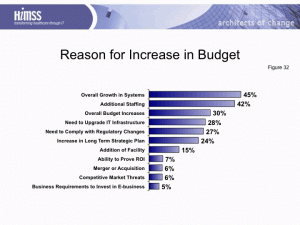 For hospital CIOs, 2011 and 2012 are all about achieving meaningful use, focusing on clinical systems, safe-keeping health information, and staying financially healthy as an organization. These insights are brought to you by the 22nd Annual HIMSS Leadership Survey, sponsored by Citrix.
For hospital CIOs, 2011 and 2012 are all about achieving meaningful use, focusing on clinical systems, safe-keeping health information, and staying financially healthy as an organization. These insights are brought to you by the 22nd Annual HIMSS Leadership Survey, sponsored by Citrix.
This survey has become the most important snapshot of health CIOs’ priorities looking ahead. This year’s survey results, unveiled week at HIMSS 2011 in Orlando, held some important findings.
While achieving meaningful use is the top IT priority for the next two years (with 81% of organizations believing they’ll quality for MU in 2011 or 2012), clinical systems implementation and patient quality remain top-of-mind for health CIOs. Thus implementing computerized patient order entry systems (CPOE), focusing on physician systems, and linking clinical systems with quality metrics are all important goals for clinical systems that fall under the big umbrella of improving patient care. Improving quality outcomes is in fact the #1 area where hospital CIOs see IT can most impact patient care.
 A parallel business objective for hospital CIOs is to improve operational efficiencies and sustain financial viability. On that score, most CIOs expect to spend a lot more money on staffing health IT departments: one of the most significant barriers to implementing IT. 2 in 3 CIOS expect to increase their HIT staff in the next 12 months, especially in the clinical areas like application support, informatics and transformation. 12% of CIOs are looking for “clinical champions” to join their staffs, a relatively new job category in information technology. Thus, 3/4 of CIOs expect increases in their IT operating budgets owing to (1) growth in systems and (2) growth in staffing.
A parallel business objective for hospital CIOs is to improve operational efficiencies and sustain financial viability. On that score, most CIOs expect to spend a lot more money on staffing health IT departments: one of the most significant barriers to implementing IT. 2 in 3 CIOS expect to increase their HIT staff in the next 12 months, especially in the clinical areas like application support, informatics and transformation. 12% of CIOs are looking for “clinical champions” to join their staffs, a relatively new job category in information technology. Thus, 3/4 of CIOs expect increases in their IT operating budgets owing to (1) growth in systems and (2) growth in staffing.
IT security remains a huge worry for hospital CIOs, 26% of whom have seen a security breach in their institutions in the past 12 months. The top concerns here are internal breaches of security, noted by 36% of CIOs, compliance with HIPAA and CMS recognized by 30%, inadequate support for security among 17% of CIOs, and data leakage noted by 16%.
For the final web-based survey, a total of 326 responses were received between December 3, 2010 and January 31, 2011. Survey respondents represented nearly 700 U.S. hospitals, with average bed size of 512 and median bed size of 330.
Health Populi’s Hot Points: In a related survey conducted by Modern Healthcare, 54% of health care executives overall said they have difficulty recruiting or retaining enough appropriately skilled IT workers. Underneath this number were 58% of hospital leaders saying they had difficulty recruiting for HIT positions, and 33% of medical group practice leaders experiencing IT staffing challenges. In addition to a lack of supply of IT talent in local markets, this talent is also expensive to recruit: 23% of health execs said the high cost of experienced IT people is a barrier to recruiting them, coupled with 18% who said they offered lower salaries to these potential recruits.
While community colleges around the U.S. are developing curricula to increase graduates in health IT, much of the demand for HIT talent is for clinical informaticists — which is not the kind of higher- and specialty-skilled IT talent a community college can graduate.
The Secretary of Health and Human Services Kathleen Sebelius told HIMSS11 attendees that, “We believe in health information technology because it’s an investment in a stronger economy….In the Obama Administration, we look at health IT not just as an opportunity to grow our economy, but also as a powerful tool to improve health. That’s why we’ll keep working to support these technologies in the years to come. But we also need your help. First, we need you to be part of the conversation about improving health care in America. Health reform needs health IT. But health IT also needs health reform. Ultimately, the market for electronic health records will be determined by how useful they are to clinicians and hospitals. And that will depend on the success of reform.”
Health reform and health IT also needs more highly skilled information technology workers. There’s no implementing EHRs, HIEs, or any other IT tool without adding health IT talent to the labor pool.




 Thanks to Feedspot for naming this blog, Health Populi, as a
Thanks to Feedspot for naming this blog, Health Populi, as a